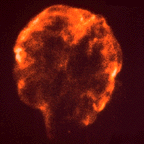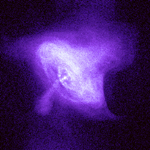Supernova Remnants
A supernova remnant (SNR) is the remains of a supernova explosion. SNRs are extremely important for understanding our galaxy. They heat up the interstellar medium, distribute heavy elements throughout the galaxy, and accelerate cosmic rays.
How do we Classify Supernova Remnants?
- Shell-type remnants:
- The Cygnus Loop (above left) is an example of a shell-type remnant. As the shockwave from the supernova explosion plows through space, it heats and stirs up any interstellar material it encounters, which produces a big shell of hot material in space. We see a ring-like structure in this type of SNR because when we look at the shell, there is more hot gas in our line of sight at the edges than when we look through the middle. Astronomers call this phenomenon limb brightening.
- Crab-like remnants:
- These remnants are also called pulsar wind nebulae or plerions, and they look more like a "blob" than a "ring," in contrast to the shell-like remnants. The nebulae are filled with high-energy electrons that are flung out from a pulsar in the middle. These electrons interact with the magnetic field, in a process called synchrotron radiation, and emit X-rays, visible light and radio waves. The most famous nebula is the Crab Nebula (above right), hence the common name, "Crab-like remnants."
- Composite Remnants
- These remnants are a cross between the shell-type remnants and crab-like remnants. They appear shell-like, crab-like or both, depending on what part of the electromagnetic spectrum one is observing them in. There are two kinds of composite remnants: thermal and plerionic.
- Thermal composites:
- These SNRs appear shell-type in the radio waveband (synchrotron radiation). In X-rays, however, they appear crab-like, but unlike the true crab-like remnants their X-ray spectra have spectral lines, indicative of hot gas.
- Plerionic composites:
- These SNRs appear crab-like in both radio and X-ray wavebands; however, they also have shells. Their X-ray spectra in the center do not show spectral lines, but the X-ray spectra near the shell do have spectral lines.
How do we know a supernova remnant's age?
Naturally, if the supernova explosion was recorded in history, as is the case of many SNRs less than a few thousand years old, we know the age of the corresponding SNR. However, sometimes historians are not certain if a recorded "guest star" was a supernova or was the same supernova as a corresponding remnant. It is therefore important to be able to estimate the age of SNRs.
An easy way to guess the age of a SNR is to measure the temperature of the hot gas using X-ray spectroscopy. From this observation we can estimate the velocity of the shock wave, and then infer the age from the shock velocity. This works because the velocity of the shock slows down with time as it engulfs more material and cools. This is easy to do, but not very accurate, because there are a number of complicated processes that can heat up or cool down the gas which are independent of shock velocity.
A better way, which works well for the youngest SNRs, is to measure a SNR's expansion over time and apply the equation
rate x time = distance
For example, if we observed a supernova remnant both 20 years ago and today, we would have two images 20 years apart. Comparing the sizes of the two images and dividing the difference by 20 years, yields the rate at which the SNR is expanding. For example, if we found that the supernova remnant expanded by 5% over the 20 year period, then the the rate of expansion would be:
rate = 5/ 20 years = 0.25 /year
Because the SNR expanded 100% since it exploded, its age can be calculated in the following manner:
time = 100/ (0.25 /year) = 400 years
With the above example, it is safer to say that the supernova explosion happened less than 400 years ago, because it is quite likely that the SNR's expansion has slowed down since the explosion (whereas it is unlikely to have sped up). An age calculated according to this method is more likely to be accurate when calculated for the fasting moving features in the supernova remnant or the result agrees with historical records.
Why are supernova remnants important to us?
Supernova remnants greatly impact the ecology of the Milky Way. If it were not for SNRs, there would be no Earth, and hence, no plants or animals or people. This is because all the elements heavier than iron were made in a supernova explosion, so the only reason we find these elements on Earth or in our Solar System — or any other extrasolar planetary system — is because those elements were formed during a supernova.
The gas that fills the disk of the Milky Way is called the interstellar medium (ISM). In the parts of the galaxy where the ISM is most dense (for example, in the galaxy's spiral arms), the ISM gas can collapse into clumps. Clumps that are above a critical mass (somewhere between the mass of Jupiter and the Sun) will ignite nuclear fusion when the clumps gravitationally collapse, forming stars. Therefore, the chemical composition of the ISM becomes the chemical composition of the next generation of stars.
Because supernova remnants introduce supernova ejecta (including the newly formed elements) into the ISM, if it were not for supernova remnants, our Solar System, with its rocky planets, could never have formed.
What else do SNRs do to the galaxy?
In addition to enriching galaxies with heavy elements, supernova remnants release a great deal of energy to the ISM (1028 megatons per supernova). As the shockwave moves outward, it sweeps across a large volume of the ISM, impacting the ISM in two primary ways:
- The shockwave heats the gas it encounters, not only raising the overall temperature of the ISM, but also making some parts of the galaxy hotter than others. These temperature differences help to keep the Milky Way a dynamic and interesting place.
- The shockwave accelerates electrons, protons and ions (via the Fermi acceleration process) to velocities very close to the speed of light. This phenomenon is very important, because the origin of the galactic cosmic rays is one of great outstanding problems in astrophysics. Most astronomers believe that most cosmic rays in our galaxy used to be part of the gas in the ISM, until they got caught in a supernova shock wave. By rattling back and forth across the shock wave, these particles gain energy and become cosmic rays. However, astronomers still debate to what maximum energy SNRs can accelerate cosmic rays — the current best guess is about 1014 eV/nucleon.
What are the life stages of an SNR?
The life stages of an SNR represent an area of current study. However, basic theories yield a three-phase analysis of SNR evolution:
- In the first phase, free expansion, the front of the expansion is formed from the shock wave interacting with the ambient ISM. This phase is characterized by constant temperature within the SNR and constant expansion velocity of the shell. It lasts a couple hundred years.
- During the second phase, known as the Sedov or Adiabatic Phase, the SNR material slowly begins to decelerate by 1/r(3/2) and cool by 1/r3 (r being the radius of the SNR). In this phase, the main shell of the SNR is Rayleigh-Taylor unstable, and the SNR's ejecta becomes mixed up with the gas that was just shocked by the initial shock wave. This mixing also enhances the magnetic field inside the SNR shell. This phase lasts 10,000 - 20,000 years.
- The third phase, the Snow-plow or Radiative phase, begins after the shell has cooled down to about 106 K. At this stage, electrons begin recombining with the heavier atoms (like oxygen) so the shell can more efficiently radiate energy. This, in turn, cools the shell faster, making it shrink and become more dense. The more the shell cools, the more atoms can recombine, creating a snowball effect. Because of this snowball effect, the SNR quickly develops a thin shell and radiates most of its energy away as optical light. The velocity now decreases as 1/r3. Outward expansion stops and the SNR starts to collapse under its own gravity. This lasts a few hundreds of thousands of years. After millions of years, the SNR will be absorbed into the interstellar medium due to Rayleigh-Taylor instabilities breaking material away from the SNR's outer shell.
For more general information on SNRs, see:
Astronomy, The Cosmic Perspective by Zeilik and Gaustad
A good book on SNRs and supernovae, written for the non-scientist is:
The Supernova Story, by Laurence A. Marschall, ©1988, Plenum Press, ISBN 0306429551
For more information on types of SNRs, see:
Weiler K., and Sramek, R. 1988. Ann Rev. Astron. Astrophys. 26: 295-341
For more information on SNR evolution, see:
Chevalier, R.A. 1977. Ann. Rev. Astron. Astrophys. 15: 175-96
For more information on SNR and soft X-rays, see:
Gorenstein, P., Tucker, W.H. 1976. Ann. Rev. Astron. Astrophys. 14: 373-414
Last Modified: March 2011




